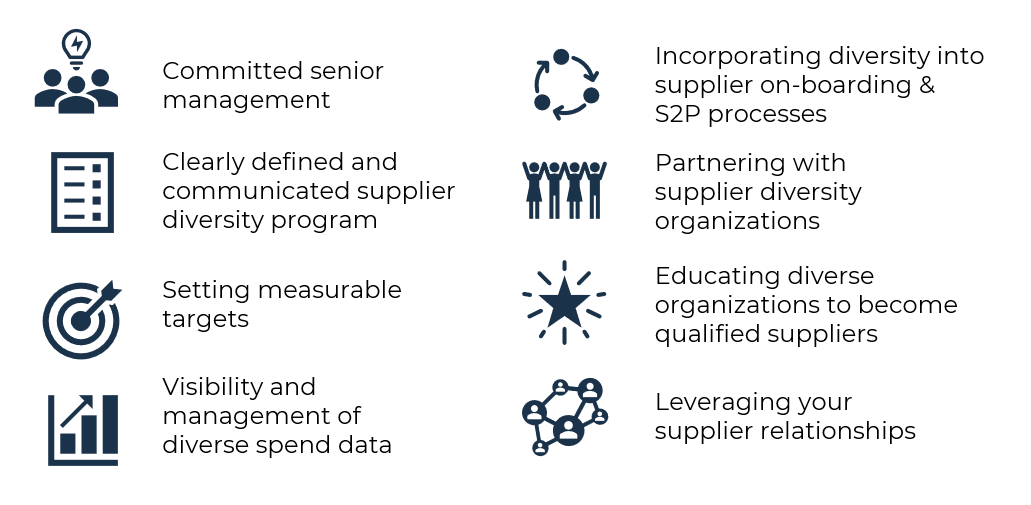Supplier diversity is a proactive procurement strategy that encourages organizations to include minority-owned businesses that are underrepresented in their supply base.
Organizations classify diverse suppliers in various ways. They commonly include 51% minority-owned, women-owned, veteran-owned, disabled-owned, and LGBTQIA+-owned enterprises.
More recently, classifications have expanded to include specific minority sub-groups. In the United States, there are more than 15 categories used to identify diverse businesses.
However, like most procurement initiatives, clear KPIs are important. In this article, we'll cover the best supplier diversity calculations and success metrics.

Why is it important for procurement?
A supplier diversity program promotes the use of traditionally excluded groups. Leading companies across all industries are embracing supplier diversity for both economic and societal reasons.
Pioneers in this area include Coca-Cola, UPS, Delta Airlines, and IBM. It is a meaningful strategy for sustainable procurement, while also increasing resilience and agility.
These programs are slowly moving away from being a corporate social responsibility (CSR) driven initiative to being a business imperative and driver of competitive advantage.
They are being adopted not only to manage corporate reputation but also to invest in local communities and contribute to corporate diversity culture.
Some benefits impact wider economic and social development. According to Dun & Bradstreet, minority-owned businesses in the USA between 2013-2014 contributed jobs for 2.2 million people, women-owned businesses contributed 7.9 million jobs, and LGBT-owned businesses contribute 2.4 million jobs.
The National Minority Supplier Development Council (NMSDC) in their 2018/2019 yearly report state these astonishing projections:
From 2000-2045, 3.3 million minority business owners will grow
- 17% annually
- 24% annually in sales
- 70% of total increase purchasing power.
Supplier diversity uplifts local communities, in the areas where businesses are located, through job creation, increased wages, and tax revenue.
Campbell’s Soup has called Camden, New Jersey home for over 150 years. As part of their strategy, they have pledged to increase their procurement spend with New Jersey-based small and diverse suppliers by 25%, by 2025.
Expanding the supplier base reveals sourcing opportunities that promote competition, improve product quality, bring new solutions, and drive innovation.
Metrics for Supplier Diversity
Organizations are measuring the economic and social impact of their diversity programs to support their business goals, not only for the sake of compliance and CSR reporting.
The aim is to get a clear picture of the positive impact on the bottom line and on the communities the company serves.
The preferred method of authenticating and classifying diverse suppliers is through the use of third-party certification agencies.
Spend analysis solutions provide opportunities to track and measure the share of diverse supplier spend out of total category spend. You need to know the current state of your supplier diversity in order to improve and set purposeful diversity targets on category level.
Supplier Diversity Metrics
The types of diversity metrics used will depend on the organization’s industry sector, geographic location, size, and the objectives of its supplier diversity program.
These and other insights enable a company to review its supplier diversity performance, address some of the challenges and set new targets.
Common supplier diversity metrics include:
-
Total spend on diverse suppliers by department/division/location
-
Spend per category of diverse suppliers, e.g., veterans, women-owned
-
Diverse spend per sourcing category, e.g., I.T., MRO, logistics
-
Number of new suppliers engaged by diverse category
The spend on purchasing goods and services from diverse suppliers, if correctly classified, is measurable.
Indirect spend, and hence indirect impact, is more difficult to measure. The wider impact of diverse spending can include job creation and wider economic benefits to the local community.
Certification
Supplier diversity certification is important because it validates that the business is owned, managed, and controlled by a qualifying company.
In the US there are entities such as the Women’s Business Enterprise National Council (WBENC) and the U.S. Department of Veterans Affairs - Vets First Verification Program that focus on offering nationally recognized third-party certification services.
Certification forms the basis for new supplier approval before onboarding and it also assists with categorization for reporting purposes.
Warning: the certification process sometimes receives criticism, as it can present difficulties for small businesses that do not have the funds or the capacity to become accredited by a third-party agency. But for the most part, it's the best we've got.
Challenges in diverse procurement
Small, emerging and diverse businesses often have limited access to capital and funding and may have little knowledge of the processes required to become accredited.
There is a growing trend for buying organizations to support them in the certification process on a practical level.
A challenge for the buying organization is verification of actual ownership and confirming that the business is legit. Subscribing to certification programs helps but there is still a risk of fronting and misrepresentation.
Finding minority-owned suppliers that comply with quality, quantity, security, and safety requirements can become an obstacle.
Large companies with enough resources are creating mentoring and training programs to help diverse suppliers meet the required standards. These initiatives also have the spin-off in that it benefits other buying organizations too.
8 Success factors in Supplier Diversity
Removing obstacles standing in the way of achieving diversity goals is the first step. Successful diversity program steps include:
-
Get commitment from senior management. Every firm on making strides in supplier diversity has a CEO who personally signed off on goals and metrics.
-
Establish a clearly defined and communicated supplier diversity program with measurable targets. Communicating your efforts enables diverse vendors or diversity-related organizations learn about your initiatives and potentially encourages them to reach out to you.
-
Get visibility of the supplier data. Digitization makes diversity tracking easier. Cloud-based spend analysis solutions can provide ways to identify and categorize suppliers.
-
Monitor and track spend in each diverse supplier category on an ongoing basis.
-
Partner up with an organization that supports diversity. There are organizations that specialize in diversity and can help you add new vendors that broaden your network.
-
Embed diversity into supplier onboarding, sourcing and the Procure-to-Pay (P2P) processes.
-
Assist diverse organizations to become suppliers to your organization. You may want to consider offering an educational program to help diverse business owners navigate through your supplier qualification process.
-
Leverage your supplier relationships. Communicating your diversity targets to your existing partners gives them an opportunity to seek for diverse alternatives further down the chain. As you start working with diverse suppliers you may be able to access new networks of diverse partners that you may not have otherwise been exposed to.

To learn more about how to create a holistic Sustainable Procurement strategy to serve the triple bottom line, read our complete guide Sustainable Procurement 101.
Header photo by: Brian Wangenheim (unsplash)





